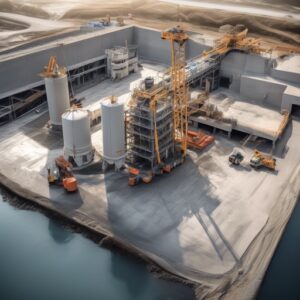Ready mix concrete has become an essential component of modern construction projects, offering convenience, efficiency, and consistency. At the heart of this industry lie ready mix plants, where concrete is batched, mixed, and prepared for delivery to construction sites. Understanding how these plants operate is crucial for anyone involved in the construction industry or curious about the process behind the concrete that builds our world.
Understanding Ready Mix Plants
- Ready mix plants, also known as concrete batching plants, are facilities where various ingredients are combined to produce concrete according to specific recipes.
- These ingredients typically include cement, aggregates (such as sand, gravel, or crushed stone), water, and admixtures (chemical additives that enhance certain properties of concrete).
- The primary objective of a ready mix plant is to efficiently produce high-quality concrete in large quantities, tailored to meet the requirements of construction projects.
The Batching Process
- Batching is the first step in the operation of a ready mix plant. It involves measuring and combining the required quantities of each ingredient according to the concrete mix design.
- Modern ready mix plants are equipped with sophisticated batching systems that ensure accuracy and consistency in the mixing process.
- Computerized controls allow operators to input the desired mix proportions and monitor the entire batching process, minimizing errors and optimizing efficiency.
Mixing and Blending
- Once the ingredients are batched, they are transferred to a mixer where they are thoroughly blended to achieve a homogenous mixture.
- Mixers come in various types, including drum mixers, pan mixers, and twin-shaft mixers, each offering unique advantages in terms of mixing efficiency and speed.
- The mixing process is critical for ensuring uniform distribution of ingredients and proper hydration of cement particles, ultimately influencing the strength and durability of the concrete.
Quality Control Measures
- Quality control is paramount in ready mix plant operations to ensure that the produced concrete meets the required specifications and standards.
- Quality control measures may include regular testing of raw materials, monitoring of batching and mixing processes, and conducting strength and durability tests on concrete samples.
- By implementing rigorous quality control protocols, ready mix plants can uphold their reputation for delivering consistent and reliable concrete products.
Environmental Considerations
- Ready mix plants are mindful of their environmental impact and strive to minimize resource consumption and emissions.
- Recycling systems may be employed to reuse water and aggregates from returned concrete, reducing waste and conserving natural resources.
- Additionally, modern ready mix plants may incorporate technologies such as dust collection systems and alternative fuel sources to mitigate air pollution and energy consumption.
Transportation and Delivery
- Once the concrete is mixed and quality-checked, it is loaded onto specialized trucks known as ready mix concrete trucks or transit mixers.
- These trucks have rotating drums that continuously agitate the concrete during transit to maintain its consistency.
- Prompt delivery of concrete to construction sites is essential to prevent setting before placement and ensure optimal workability and performance.
Conclusion
Ready mix plants near me play a pivotal role in the construction industry by supplying high-quality concrete for a wide range of projects, from residential buildings to infrastructure developments. Understanding the intricacies of their operations sheds light on the meticulous processes involved in producing concrete that meets the demands of modern construction standards. By prioritizing efficiency, quality control, and environmental sustainability, ready mix plants continue to be indispensable contributors to the built environment, shaping the landscapes of tomorrow.


